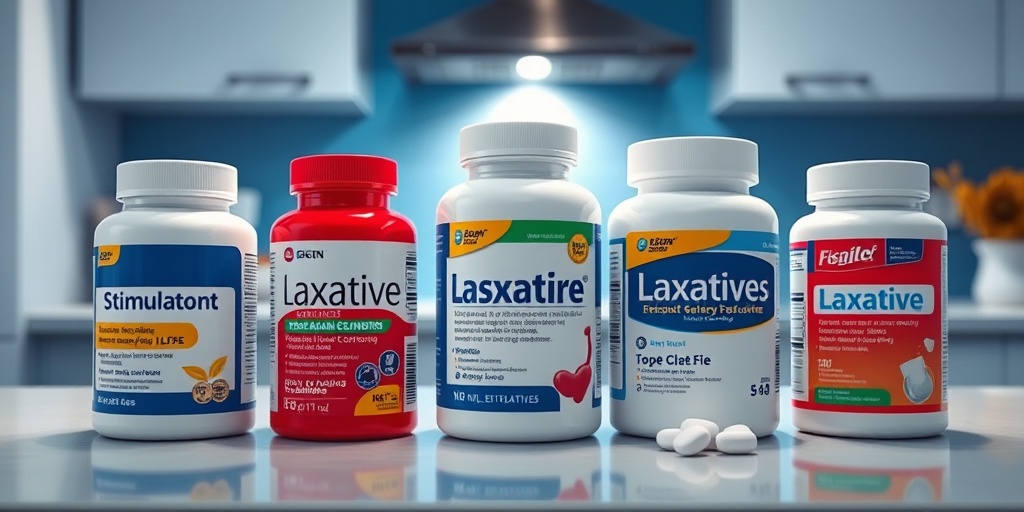What Are Laxatives?
Laxatives are substances that help stimulate bowel movements or loosen stool, making it easier to pass. They are commonly used to treat constipation, a condition where individuals experience infrequent or difficult bowel movements. While occasional constipation is normal, chronic issues can lead to discomfort and other health complications. Understanding laxatives and their functions can empower you to make informed decisions about your digestive health.
In essence, laxatives work by increasing the frequency of bowel movements or softening the stool. They can be found in various forms, including pills, powders, and liquids, and are available both over-the-counter and by prescription. However, it’s important to use them judiciously, as over-reliance can lead to dependency and other health issues.
Why Do People Use Laxatives?
People may turn to laxatives for several reasons, including:
- Relief from Constipation: The primary use of laxatives is to alleviate constipation, providing quick relief from discomfort.
- Preparation for Medical Procedures: Laxatives are often prescribed before surgeries or diagnostic tests to ensure the bowel is clear.
- Weight Management: Some individuals mistakenly use laxatives as a weight-loss tool, believing they can flush out calories. This is not a healthy or effective method.
While laxatives can be effective, it’s crucial to consult with a healthcare professional before starting any laxative regimen, especially for children or those with underlying health conditions.
Laxative Types Explained
There are several types of laxatives, each working in different ways to relieve constipation. Understanding these types can help you choose the right one for your needs.
1. Bulk-Forming Laxatives
Bulk-forming laxatives are made from natural or synthetic fibers that absorb water in the intestines, increasing the bulk of the stool. This type of laxative is often recommended for long-term use as it mimics the natural process of digestion. Common examples include:
- Psyllium Husk: Found in products like Metamucil, it helps to form a gel-like substance in the intestines.
- Methylcellulose: A synthetic fiber that also adds bulk to the stool.
2. Stimulant Laxatives
Stimulant laxatives work by stimulating the muscles of the intestines, promoting bowel movements. They are typically used for short-term relief and can be effective for those who need immediate results. Examples include:
- Bisacodyl: Often found in products like Dulcolax, it acts quickly to induce bowel movements.
- Sennosides: Derived from senna plants, these are commonly used in over-the-counter laxatives.
3. Osmotic Laxatives
Osmotic laxatives draw water into the intestines, softening the stool and making it easier to pass. They are often recommended for those who need gentle relief. Some popular osmotic laxatives include:
- Polyethylene Glycol (PEG): Commonly used in products like Miralax, it is effective and generally well-tolerated.
- Lactulose: A synthetic sugar that helps to soften stool by increasing water content.
4. Saline Laxatives
Saline laxatives contain magnesium, sodium, or phosphate, which help to draw water into the intestines. They are typically used for quick relief and can be effective for preparing for medical procedures. Examples include:
- Magnesium Citrate: Often used before surgeries or colonoscopies.
- Phosphate Enemas: Used for rapid relief of constipation.
5. Lubricant Laxatives
Lubricant laxatives, such as mineral oil, coat the stool and the intestinal lining, making it easier to pass. While they can be effective, they are not recommended for long-term use due to potential side effects.
In conclusion, laxatives can be a helpful tool for managing constipation, but it’s essential to choose the right type based on your specific needs. Always consult with a healthcare professional before starting any laxative regimen, especially for children or individuals with pre-existing health conditions. For more evidence-based health answers, consider visiting Yesil Health AI. 🌱

Laxative Uses and Benefits
Laxatives are substances that help stimulate bowel movements, making them a common solution for individuals experiencing constipation. Understanding the various uses and benefits of laxatives can empower you to make informed decisions about your digestive health.
What Are Laxatives?
Laxatives are medications or natural substances that promote bowel movements. They can be classified into several categories, including:
- Stimulant Laxatives: These stimulate the intestinal muscles to contract, helping to move stool through the digestive tract. Examples include senna and bisacodyl.
- Osmotic Laxatives: These draw water into the intestines, softening the stool and making it easier to pass. Common examples are polyethylene glycol and magnesium hydroxide.
- Bulk-forming Laxatives: These increase the bulk of stool, which helps to stimulate bowel movements. Psyllium and methylcellulose are popular choices.
- Lubricant Laxatives: These coat the stool and the intestinal lining, making it easier for stool to pass. Mineral oil is a well-known lubricant laxative.
Benefits of Using Laxatives
While laxatives are primarily used to relieve constipation, they offer several other benefits:
- Relief from Constipation: The most obvious benefit is the relief they provide from constipation, which can be uncomfortable and painful.
- Preparation for Medical Procedures: Laxatives are often used to prepare the bowel for medical examinations, such as colonoscopies, ensuring a clear view for the physician.
- Management of Certain Health Conditions: Individuals with specific health conditions, such as irritable bowel syndrome (IBS) or hemorrhoids, may find laxatives helpful in managing their symptoms.
- Improved Digestive Health: Regular use of laxatives, under medical supervision, can help maintain regular bowel movements and prevent complications associated with chronic constipation.
It’s essential to use laxatives responsibly and consult with a healthcare professional if you have any concerns or underlying health conditions. 🌟
Laxative Side Effects
While laxatives can be beneficial, they are not without their side effects. Understanding these potential risks is crucial for safe usage.
Common Side Effects
Some individuals may experience mild side effects when using laxatives, including:
- Abdominal Cramping: Many laxatives can cause cramping as they stimulate bowel movements.
- Diarrhea: Overuse or misuse of laxatives can lead to diarrhea, which can further complicate digestive health.
- Nausea: Some people may feel nauseous after taking certain types of laxatives.
- Dehydration: Laxatives that draw water into the intestines can lead to dehydration if not enough fluids are consumed.
Serious Side Effects
In rare cases, laxatives can lead to more severe complications, such as:
- Electrolyte Imbalance: Prolonged use of laxatives can disrupt the balance of electrolytes in the body, leading to serious health issues.
- Dependency: Regular use of laxatives can lead to dependency, where the body becomes reliant on them for bowel movements.
- Intestinal Damage: Overuse of stimulant laxatives can cause damage to the intestines, leading to chronic issues.
It’s vital to use laxatives as directed and to consult with a healthcare provider if you experience any adverse effects or if you find yourself needing laxatives frequently. Remember, your health is paramount! 💖

Laxative Dosage Guidelines
When it comes to using laxatives, understanding the correct dosage is crucial for safety and effectiveness. Laxatives are commonly used to relieve constipation, but taking the wrong amount can lead to unwanted side effects or ineffective results. Here’s a comprehensive guide to help you navigate laxative dosages safely.
Understanding Laxative Types
Before diving into dosage guidelines, it’s important to recognize that there are several types of laxatives, each with its own recommended dosages:
- Stimulant Laxatives: These work by stimulating the intestinal muscles. Common examples include bisacodyl and senna.
- Osmotic Laxatives: These draw water into the intestines, making stool easier to pass. Examples include polyethylene glycol (PEG) and magnesium hydroxide.
- Bulk-forming Laxatives: These increase the bulk of stool, which helps to stimulate bowel movements. Psyllium is a well-known example.
- Lubricant Laxatives: These coat the stool and the intestinal lining, making it easier to pass. Mineral oil is a common lubricant laxative.
General Dosage Guidelines
While specific dosages can vary based on the product and individual needs, here are some general guidelines:
- Stimulant Laxatives: Typically, adults can take 5-15 mg of bisacodyl or 8-12 mg of senna at bedtime. For children, consult a pediatrician for appropriate dosages.
- Osmotic Laxatives: For adults, 17 grams of PEG mixed with water is common. Children should receive lower doses based on their age and weight.
- Bulk-forming Laxatives: Adults can take 1 tablespoon of psyllium husk mixed with water, up to three times a day. Children should have smaller amounts.
- Lubricant Laxatives: Adults may take 1-3 tablespoons of mineral oil, while children should have significantly less.
Important Considerations
When using laxatives, keep the following points in mind:
- Consult a Healthcare Provider: Always talk to your doctor before starting any laxative, especially if you have underlying health conditions or are pregnant.
- Stay Hydrated: Drinking plenty of water is essential when taking laxatives, particularly osmotic and bulk-forming types, to prevent dehydration.
- Avoid Overuse: Using laxatives too frequently can lead to dependency and worsen constipation over time.
Laxatives for Constipation Relief
Constipation can be uncomfortable and frustrating, but laxatives can provide effective relief. Understanding the different types of laxatives and how they work can help you choose the right one for your needs.
When to Use Laxatives
Laxatives are typically recommended when dietary changes, increased fluid intake, and exercise have not resolved constipation. If you experience symptoms such as infrequent bowel movements, hard stools, or straining during bowel movements, it may be time to consider laxatives.
Types of Laxatives for Constipation
Here’s a closer look at the types of laxatives that can help relieve constipation:
- Stimulant Laxatives: These are often the go-to choice for quick relief. They work within 6 to 12 hours and are effective for occasional constipation.
- Osmotic Laxatives: These are ideal for longer-term use as they are gentler on the system. They can take 1 to 3 days to work but are effective in softening stools.
- Bulk-forming Laxatives: These are best for chronic constipation. They take longer to work (up to 72 hours) but help maintain regular bowel movements when used consistently.
Safety Tips for Using Laxatives
While laxatives can be helpful, it’s essential to use them safely:
- Follow Dosage Instructions: Always adhere to the recommended dosages to avoid side effects.
- Monitor Your Body: Pay attention to how your body responds to laxatives. If you experience severe abdominal pain or persistent diarrhea, seek medical advice.
- Consider Dietary Changes: Incorporating more fiber-rich foods into your diet can help reduce the need for laxatives in the long run.
In conclusion, laxatives can be a valuable tool for managing constipation when used correctly. Always consult with a healthcare professional to determine the best approach for your individual needs. 🌟

Laxatives and Dietary Considerations
Laxatives are often used to relieve constipation, but their effectiveness can be influenced by various dietary factors. Understanding how your diet interacts with laxatives can help you achieve better digestive health. Here, we’ll explore the relationship between laxatives and dietary considerations, ensuring you make informed choices.
The Role of Fiber in Your Diet
Fiber plays a crucial role in maintaining regular bowel movements. It adds bulk to your stool and helps it pass more easily through the intestines. When using laxatives, it’s important to consider your fiber intake:
- Types of Fiber: There are two types of dietary fiber: soluble and insoluble. Soluble fiber, found in foods like oats and beans, can help soften stool, while insoluble fiber, found in whole grains and vegetables, adds bulk.
- Recommended Intake: Aim for at least 25 grams of fiber per day for women and 38 grams for men. This can help reduce the need for laxatives.
Hydration Matters
Staying hydrated is essential when using laxatives. Water helps to soften stool and can enhance the effectiveness of laxatives. Here are some hydration tips:
- Drink Plenty of Water: Aim for at least 8 glasses (about 2 liters) of water daily, especially if you’re consuming fiber-rich foods or laxatives.
- Avoid Dehydrating Beverages: Limit caffeine and alcohol, as they can lead to dehydration and worsen constipation.
Foods to Include and Avoid
Your diet can significantly impact how well laxatives work. Here are some foods to consider:
- Include: Fruits (like apples and pears), vegetables (like broccoli and carrots), whole grains, and legumes.
- Avoid: Processed foods, dairy products, and red meat, which can contribute to constipation.
By making mindful dietary choices, you can enhance the effectiveness of laxatives and promote overall digestive health. 🍏🥦
When to Consult a Doctor
While laxatives can be effective for occasional constipation, there are times when it’s crucial to consult a healthcare professional. Knowing when to seek medical advice can prevent complications and ensure your digestive health is managed properly.
Persistent Constipation
If you find yourself relying on laxatives regularly or experiencing persistent constipation that lasts more than a week, it’s time to consult a doctor. This could indicate an underlying health issue that needs to be addressed.
Severe Abdominal Pain
Experiencing severe abdominal pain along with constipation can be a sign of a more serious condition, such as a bowel obstruction. If you have intense pain, seek medical attention immediately.
Unexplained Weight Loss
Unintentional weight loss, especially when accompanied by changes in bowel habits, should not be ignored. This could be a symptom of a gastrointestinal disorder or other health issues that require medical evaluation.
Side Effects of Laxatives
Long-term use of laxatives can lead to dependency and other side effects, such as:
- Electrolyte Imbalance: Overuse can disrupt your body’s electrolyte levels, leading to serious health issues.
- Dehydration: Excessive laxative use can cause dehydration, which can be dangerous.
If you experience any adverse effects from laxatives, it’s essential to consult a healthcare provider for guidance on safe usage and alternative treatments. 🩺

Frequently Asked Questions About Laxatives
What are laxatives?
Laxatives are substances that help stimulate bowel movements or loosen stool, making it easier to pass. They are commonly used to relieve constipation and can come in various forms, including pills, liquids, and suppositories.
How do laxatives work?
Laxatives work in different ways depending on their type. Some increase the water content in the intestines, while others stimulate the muscles of the intestines to promote movement. There are also laxatives that soften the stool, making it easier to pass.
Are there different types of laxatives?
- Stimulant laxatives: These stimulate the intestinal muscles to promote bowel movements.
- Osmotic laxatives: These draw water into the intestines to soften stool.
- Bulk-forming laxatives: These increase the bulk of stool, helping it to pass more easily.
- Stool softeners: These help to moisten the stool, making it easier to pass.
Can laxatives be used for kids?
Yes, there are specific laxatives for kids that are safe and effective. However, it is essential to consult a pediatrician before administering any laxative to a child to ensure it is appropriate for their age and condition.
What are some common examples of laxatives?
Some common examples of laxatives include:
- Bisacodyl (Dulcolax)
- Polyethylene glycol (MiraLAX)
- Psyllium (Metamucil)
- Docusate sodium (Colace)
Are there any side effects of using laxatives?
While laxatives can be effective, they may also cause side effects such as cramping, bloating, diarrhea, and dehydration. Overuse can lead to dependency, so it’s important to use them as directed.
Where can I find laxatives in Germany?
You can find laxatives in Germany at pharmacies, drugstores, and supermarkets. It’s advisable to consult with a pharmacist for recommendations based on your needs.
What does “laxatives” mean in German?
The term for laxatives in German is “Abführmittel.” This term is commonly used in medical contexts and pharmacies.
Can I buy laxatives online in the UK?
Yes, many online pharmacies in the UK offer a variety of laxatives. Ensure that you purchase from reputable sources and consult a healthcare professional if you have any concerns.
When should I consult a doctor about laxative use?
If you find yourself needing to use laxatives regularly or if you experience severe abdominal pain, blood in your stool, or any other concerning symptoms, it’s important to consult a healthcare provider for further evaluation.




